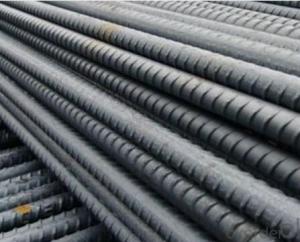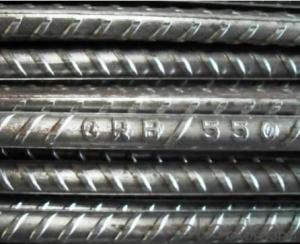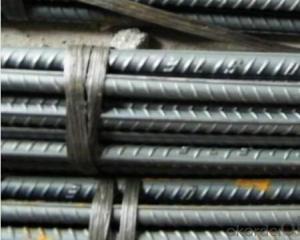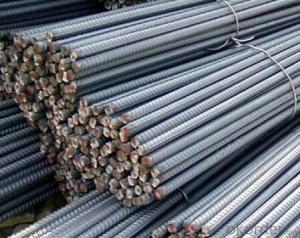Deformed Steel Bar with Standard ASTM A615
- Loading Port:
- Tianjin
- Payment Terms:
- TT OR LC
- Min Order Qty:
- 100 m.t.
- Supply Capability:
- 5000 m.t./month
OKorder Service Pledge
OKorder Financial Service
You Might Also Like
Product Description:
OKorder is offering Deformed Steel Bar with Standard ASTM A615 at great prices with worldwide shipping. Our supplier is a world-class manufacturer of steel, with our products utilized the world over. OKorder annually supplies products to European, North American and Asian markets. We provide quotations within 24 hours of receiving an inquiry and guarantee competitive prices.
Product Applications:
Deformed Steel Bar with Standard ASTM A615 are ideal for structural applications and are widely used in the construction of buildings and bridges, and the manufacturing, petrochemical, and transportation industries.
Product Advantages:
OKorder's Deformed Steel Bar with Standard ASTM A615 are durable, strong, and resist corrosion.
Main Product Features:
· Premium quality
· Prompt delivery & seaworthy packing (30 days after receiving deposit)
· Corrosion resistance
· Can be recycled and reused
· Mill test certification
· Professional Service
· Competitive pricing
Specifications of Deformed Steel Bar with Standard ASTM A615:
Standard | GB UK USA | HRB335 HRB400 HRB500 G460B, B500A, B500B,B500C GR40, GR60 | |
Diameter | 6mm,8mm,10mm,12mm,14mm,16mm,18mm,20mm, 22mm,25mm,28mm,32mm,36mm,40mm,50mm | ||
Length | 6M, 9M,12M or as required | ||
Packing | Export standard packing: wrapped by wire rod in bundles | ||
Each bundle weight | 2-3MT, or as required | ||
Trade terms | FOB, CFR, CIF | ||
Payment terms | TT payment in advance or Irrevocable LC at sight. | ||
Delivery Detail | within 45 days after received advanced payment or LC. | ||
Brand name | DRAGON | ||
Theoretical weight and section area of each diameter as below for your information:
Diameter(mm) | Section area (mm²) | Mass(kg/m) | Weight of 12m (kg) | Pcs/ton |
6 | 28.27 | 0.222 | 2.664 | 375.38 |
8 | 50.27 | 0.395 | 4.74 | 210.97 |
10 | 78.54 | 0.617 | 7.404 | 135.06 |
12 | 113.1 | 0.888 | 10.656 | 93.84 |
14 | 153.9 | 1.21 | 14.52 | 68.87 |
16 | 201.1 | 1.58 | 18.96 | 52.74 |
18 | 254.5 | 2.00 | 24 | 41.67 |
20 | 314.2 | 2.47 | 29.64 | 33.74 |
22 | 380.1 | 2.98 | 35.76 | 27.96 |
25 | 490.9 | 3.85 | 46.2 | 21.65 |
28 | 615.8 | 4.83 | 57.96 | 17.25 |
32 | 804.2 | 6.31 | 75.72 | 13.21 |
36 | 1018 | 7.99 | 98.88 | 10.43 |
40 | 1257 | 9.87 | 118.44 | 8.44 |
50 | 1964 | 15.42 | 185.04 | 5.40 |
Chemical Composition: (Please kindly find our chemistry of our material based on JIS as below for your information)
JISG3112 SD390 | Chemical Composition | ||||
C | Mn | Si | S | P | |
0.22 | 1.38 | 0.4 | 0.014 | 0.022 | |
Physical capability | |||||
Yield Strength(N/cm²) | Tensile Strength(N/cm²) | Elongation (%) | |||
620 | ≥400 | 21 | |||
The production process of Deformed Steel Bar with Standard ASTM A615
1-Waling beam furnace
2-Roughing rolling group
3-Intermediate rolling train
4-Finishing rolling group
5-Water-cooling device
6-Walking beam cooler
7-Finishing equipment(including the cold scale shear,short feet collection system,
automatic counting device,bundling machine, collect bench)
Usage and Applications of Deformed Steel Bar with Standard ASTM A615:
Deformed bar is widely used in buildings, bridges, roads and other engineering construction. Big to highways, railways, bridges, culverts, tunnels, public facilities such as flood control, dam, small to housing construction, beam, column, wall and the foundation of the plate, deformed bar is an integral structure material. With the development of world economy and the vigorous development of infrastructure construction, real estate, the demand for deformed bar will be larger and larger..
Packaging & Delivery of Deformed Steel Bar with Standard ASTM A615:
Packaging Detail: products are packed in bundle and then shipped by container or bulk vessel, deformed bar is usually naked strapping delivery, when storing, please pay attention to moisture proof. The performance of rust will produce adverse effect.
Price: Keep lower operating costs so as to offer competitive price for our clients
FAQ:
Q1: Why buy Materials & Equipment from OKorder.com?
A1: All products offered byOKorder.com are carefully selected from China's most reliable manufacturing enterprises. Through its ISO certifications, OKorder.com adheres to the highest standards and a commitment to supply chain safety and customer satisfaction.
Q2: How do we guarantee the quality of our products?
A2: We have established an advanced quality management system which conducts strict quality tests at every step, from raw materials to the final product. At the same time, we provide extensive follow-up service assurances as required.
Q3: How soon can we receive the product after purchase?
A3: Within three days of placing an order, we will begin production. The specific shipping date is dependent upon international and government factors, but is typically 7 to 10 workdays.
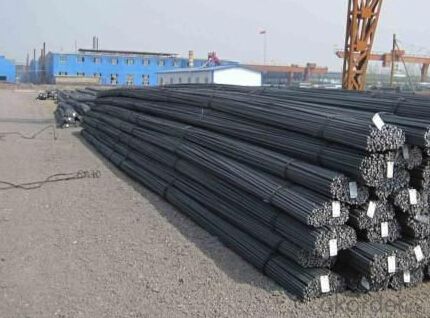
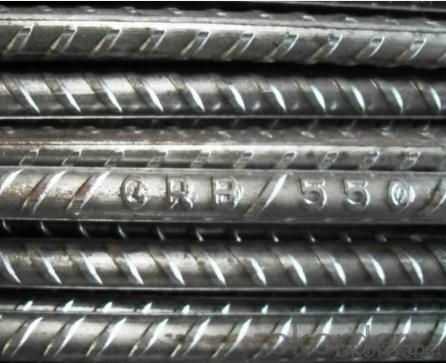
- Q:What are the common grades of steel rebars?
- Steel rebars are commonly classified based on their yield strength, which measures the force needed to deform or bend the steel. The most frequently seen grades of steel rebars are Grade 40, Grade 60, and Grade 75. Grade 40 steel rebars possess a minimum yield strength of 40,000 pounds per square inch (psi) and are often utilized in general construction projects that require moderate strength. Grade 60 steel rebars have a minimum yield strength of 60,000 psi and are extensively employed in reinforced concrete structures like bridges, buildings, and highways. They exhibit superior strength and durability compared to Grade 40 rebars, making them suitable for heavy-duty applications. Grade 75 steel rebars have a minimum yield strength of 75,000 psi and are commonly used in high-rise buildings, dams, and other structures that demand exceptional strength and load-bearing capacity. These rebars provide the highest level of strength and are specifically designed for structures exposed to extreme conditions or heavy loads. It should be noted that the selection of the appropriate grade of steel rebars for a specific project is determined by structural engineers, considering factors such as expected loads, environmental conditions, and design specifications.
- Q:Can steel rebars be used in the construction of religious buildings?
- Yes, steel rebars can be used in the construction of religious buildings. In fact, steel rebars are commonly used in various types of construction projects, including religious buildings, due to their strength, durability, and ability to reinforce concrete structures.
- Q:How are steel rebars priced in the market?
- Steel rebars are typically priced in the market based on factors such as the current cost of raw materials, supply and demand dynamics, production and transportation costs, and market competition. Additionally, the grade and quality of the rebar, as well as any additional processing or customization, can also influence the pricing.
- Q:What is the role of steel rebars in preventing concrete spalling?
- The prevention of concrete spalling is highly dependent on the presence of steel rebars. Concrete spalling occurs when the surface layer of concrete chips, cracks, or breaks due to various factors such as moisture, temperature changes, and corrosion. Steel rebars, also known as reinforcement bars, are embedded within the concrete to offer additional strength and support to the structure. When external forces or stress impact the concrete, such as heavy loads or seismic activity, the rebars assist in distributing the forces evenly throughout the structure. This prevents concentrated weak areas and reduces the chances of spalling. The rebars act as reinforcements, increasing the concrete's tensile strength and its ability to withstand tension and bending forces. Furthermore, steel rebars are instrumental in preventing spalling caused by corrosion. Concrete naturally has pores, allowing moisture and harmful substances to penetrate its surface and reach the embedded rebars. Over time, these substances can cause the steel to corrode, expanding and exerting pressure on the surrounding concrete, leading to spalling. To address this issue, rebars are typically coated with epoxy, galvanized, or made from stainless steel. These coatings serve as protective barriers against moisture and corrosive agents. The presence of this protective coating significantly reduces the risk of corrosion and subsequent spalling, thereby extending the lifespan of the concrete structure. In conclusion, steel rebars have a crucial role in preventing concrete spalling by providing reinforcement, enhancing the concrete's tensile strength, and distributing forces evenly throughout the structure. Additionally, properly coated rebars with corrosion-resistant properties help mitigate the risk of spalling caused by moisture and corrosive agents.
- Q:Can steel rebars be bent or shaped?
- Yes, steel rebars can be bent or shaped. Rebars are commonly used in construction to reinforce concrete structures, and they are often bent or shaped to fit the specific design requirements of the project. The bending or shaping of rebars can be done using various tools and techniques, such as manual bending, mechanical bending machines, or hydraulic presses. The ability to bend or shape steel rebars allows for the creation of complex and customized reinforcement patterns, ensuring that the concrete structure can withstand the intended loads and stresses.
- Q:What are the common quality control tests for steel rebars?
- Some common quality control tests for steel rebars include visual inspection for surface defects, measurement of dimensions and tolerances, tensile strength testing, bending tests, and chemical composition analysis.
- Q:What is the process of removing rust from steel rebars?
- The process of removing rust from steel rebars typically involves several steps. First, the surface of the rebars is cleaned thoroughly using a wire brush or sandpaper to remove loose rust, dirt, and any other contaminants. After cleaning, a rust converter or inhibitor may be applied to neutralize any remaining rust and prevent further corrosion. Once the converter has dried, a primer specifically designed for metal surfaces is applied to provide a protective coating. Finally, a suitable paint or coating is applied to the rebars to ensure long-term protection against rust and corrosion.
- Q:What is the maximum diameter of steel rebars used in residential construction?
- The maximum diameter of steel rebars used in residential construction typically ranges from 12 millimeters (0.47 inches) to 32 millimeters (1.26 inches).
- Q:What are the safety precautions to be followed while working with steel rebars?
- To prevent accidents and injuries while working with steel rebars, it is essential to adhere to specific safety measures. Consider the following precautions: 1. Personal Protective Equipment (PPE): Ensure that you always wear suitable PPE, including safety glasses, gloves, hard hats, and steel-toed boots. These items will shield you from potential dangers like falling objects, sharp edges, and flying debris. 2. Training and Knowledge: Before handling steel rebars, make sure you have undergone proper training and understand the associated safety protocols. Familiarize yourself with the equipment used and comprehend the potential risks involved. 3. Proper Lifting Techniques: Handling steel rebars can be challenging due to their weight and awkward shape. Always utilize correct lifting techniques, such as bending your knees and using your legs instead of your back. Do not attempt to lift a rebar that exceeds your capacity; seek assistance if necessary. 4. Secure Storage: Store steel rebars in a designated area that is free from potential obstructions. Stack them in a stable manner to prevent toppling and causing injuries. 5. Safe Handling: When moving steel rebars, exercise caution due to their sharp edges and potential for harm. Employ appropriate lifting equipment, such as cranes or forklifts, if required. Avoid dragging or sliding rebars, as this can lead to strains or sprains. 6. Fall Protection: If working at heights or near open edges, ensure that adequate fall protection measures are in place. This may involve using guardrails, safety harnesses, or safety nets to prevent falls. 7. Fire Safety: Steel rebars can become extremely hot when exposed to heat or flames. Ensure that appropriate fire prevention measures are in place, such as fire extinguishers, and exercise caution when working near flammable materials. 8. Communication: Maintain clear communication with colleagues and supervisors to ensure everyone is aware of their surroundings and potential hazards. Utilize hand signals or radios when working in noisy environments. 9. Regular Inspections: Routinely inspect steel rebars for any defects, such as cracks or sharp edges, that could pose a safety risk. Immediately remove any damaged or faulty rebars from use. 10. First Aid and Emergency Procedures: Familiarize yourself with first aid procedures and emergency protocols in the event of accidents or injuries. Have a well-stocked first aid kit readily available on-site and know the location of the nearest medical facility. By adhering to these safety precautions, you can minimize the likelihood of accidents and injuries while working with steel rebars. Always prioritize your safety and the safety of those around you.
- Q:What are the guidelines for the proper spacing of steel rebars in slabs-on-grade?
- The guidelines for the proper spacing of steel rebars in slabs-on-grade typically vary based on the specific project requirements and the structural engineering design. However, some general guidelines suggest that rebars should be spaced apart at a distance equal to or less than three times the slab thickness. Additionally, the spacing between rebars should be consistent, and there should be enough clearance between the rebars and the edges or formwork to ensure proper concrete coverage and adequate reinforcement. It is crucial to consult the project's structural engineer and adhere to local building codes for specific guidelines.
1. Manufacturer Overview |
|
|---|---|
| Location | |
| Year Established | |
| Annual Output Value | |
| Main Markets | |
| Company Certifications | |
2. Manufacturer Certificates |
|
|---|---|
| a) Certification Name | |
| Range | |
| Reference | |
| Validity Period | |
3. Manufacturer Capability |
|
|---|---|
| a)Trade Capacity | |
| Nearest Port | |
| Export Percentage | |
| No.of Employees in Trade Department | |
| Language Spoken: | |
| b)Factory Information | |
| Factory Size: | |
| No. of Production Lines | |
| Contract Manufacturing | |
| Product Price Range | |
Send your message to us
Deformed Steel Bar with Standard ASTM A615
- Loading Port:
- Tianjin
- Payment Terms:
- TT OR LC
- Min Order Qty:
- 100 m.t.
- Supply Capability:
- 5000 m.t./month
OKorder Service Pledge
OKorder Financial Service
Similar products
New products
Hot products
Related keywords
